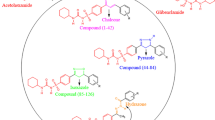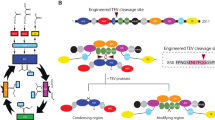Abstract
The rates of type 2 diabetes (T2D) are rising to epidemic proportions in the US and worldwide. While current T2D medications are efficacious, significant side effects have limited their use and availability. Our laboratory has discovered that abscisic acid (ABA) exerts anti-diabetic effects, in part, by activating peroxisome proliferator-activated receptor γ (PPAR γ). However, since ABA does not bind to the ligand-binding domain (LBD) of PPAR γ, the mechanism of activation of PPAR γ by ABA remains unknown. Lanthionine synthetase component C-like protein 2 (LANCL2) was predicted to be a novel target for the binding and signaling of ABA in human granulocytes and rat insulinoma cells. The goal of this study was to determine whether LANCL2 is a molecular target of ABA and other PPAR γ agonists. To this end we performed homology modeling to construct a three-dimensional structure of LANCL2 using the crystal structure of LANCL1 as a template. Our molecular docking studies predicted that ABA and other PPAR γ agonists (e.g., rosiglitazone and pioglitazone) share a binding site on the surface of LANCL2. The identification of a binding site for PPAR γ agonists will facilitate the high-throughput virtual screening of large compound libraries and may shed new light on alternative mechanisms of PPAR γ activation.










Similar content being viewed by others
References
Kumar V, Robbins SL, Cotran RS (2005) Pathologic basis of disease. Elsevier Saunders, Philadelphia
Inzucchi SE, Sherwin RS (2005) The prevention of type 2 diabetes mellitus. Endocrinol Metab Clin N Am 34:199–219
Defronzo RA (1999) Pharmacologic therapy for type 2 diabetes mellitus. Ann Intern Med 133:73–74
Defronzo RA, Ratner RR, Han J et al (2005) Effects of exenatide (exendin-4) on glycemic control and weight over 30 weeks in metformin-treated patients with type 2 diabetes. Diab Care 28:1092–1100
Rang HP, Dale MM, Ritter JM, Moore PK (2003) Pharmacology. Churchill Livingstone, New York
Nesto RW, Bell D, Bonow RO et al (2003) Thiazolidinedione use, fluid retention, and congestive heart failure: a consensus statement from the American Heart Association and American Diabetes Association. October 7, 2003. Circulation 108:2941–2948
Lewis SN, Bassaganya-Riera J, Bevan DR (2010) Virtual Screening as a Technique for PPAR Modulator Discovery. PPAR Res. Article ID 861238, 10 pages, doi:10.1155/2010/861238
Bassaganya-Riera J, Skoneczkal J, Kingston DGJ et al (2010) Mechanisms of action and medicinal applications of abscisic acid. Curr Med Chem 17:467–478
Guri A, Hontecillas R, Ferrer G et al (2008) Loss of PPAR gamma in immune cells impairs the ability of abscisic acid to improve insulin sensitivity by suppressing monocyte chemoattractant protein-1 expression and macrophage infiltration into white adipose tissue. J Nutr Biochem 19(4):216–228
Sturla L, Fresia C, Guida L et al (2009) LANCL2 is necessary for abscisic acid binding and signaling in human granulocytes and in rat insulinoma cells. J Biol Chem 284:28045–28057
Landlinger C, Salzer U, Prohaska R (2006) Myristoylation of human LanC-like protein 2 (LANCL2) is essential for the interaction with the plasma membrane and the increase in cellular sensitivity to adriamycin. Biochim Biophys Acta 1758:1759–1767
Zhang W, Wang L, Liu Y et al (2009) Structure of human lanthionine synthetase C-like protein 1 and its interaction with Eps8 and glutathione. Genes Dev 23:1387–1392
Altschul SF, Gish W, Miller W (1990) Basic local alignment search tool. J Mol Biol 215:403–410
Thompson JD, Higgins D, Gibson TJ (1994) CLUSTAL W: improving the sensitivity of progressive multiple sequence alignment through sequence weighting, position-specific gap penalties and weight matrix choice. Nucleic Acids Res 22:4673–4680
Subramaniam S (1998) The Biology Workbench-a seamless database and analysis environment for the biologist. Proteins 32:1–2
Arnold K, Bordoli L, Kopp J, Schwede T (2006) The SWISS-MODEL workspace: a web-based environment for protein structure homology modelling. Bioinformatics 22:195–201
Berman HM, Westbrook J, Feng Z (2000) The protein data bank. Nucleic Acids Res 28:235–242
Melo F, Feytmans E (1998) Assessing protein structures with a non-local atomic interaction energy. J Mol Biol 277:1141–1152
Laskowski RA, MacArthur MW, Moss D, Thornton JM (1993) PROCHECK: a program to check the stereochemical quality of protein structures. J Appl Cryst 26:283–291
Hess B, Kutzner C, van der Spoel D, Lindahl E (2008) GROMACS 4: algorithms for highly efficient, load-balanced, and scalable molecular simulation. J Chem Theory Comput 4:435–447
Jorgensen WL, Tirado-Rives J (1988) The OPLS force field for proteins. Energy minimizations for crystals of cyclic peptides and crambin. J Am Chem Soc 110:1657–1666
Wiberg KB (1965) A scheme for strain energy minimization. J Am Chem Soc 87:1070–1078
Mosca R, Schneider T (2008) RAPIDO: a web server for the alignment of protein structures in the presence of conformational changes. Nucleic Acids Res 36:W42–W46
Wang YL, Xiao J, Suzek TO et al (2009) PubChem: a public information system for analyzing bioactivities of small molecules. Nucleic Acids Res 37:W623–W633
Morris GM, Huey R, Lindstrom W et al (2009) AutoDock4 and AutoDockTools4: automated docking with selective receptor flexibility. J Comput Chem 30:2785–2791
Morris GM, Goodsell D, Halliday RS et al (1998) Automated docking using a Lamarckian genetic algorithm and an empirical binding free energy function. J Comput Chem 19:1639–1662
Hetényi C, van der Spoel D (2002) Efficient docking of peptides to proteins without prior knowledge of the binding site. Protein Sci 11:1729–1737
Hetényi C, van der Spoel D (2006) Blind docking of drug-sized compounds to proteins with up to a thousand residues. FEBS Lett 580:1447–1450
Iorga B, Herlem D, Barre E, Guillou C (2006) Acetylcholine nicotinic receptors: finding the putative binding site of allosteric modulators using the “blind docking” approach. J Mol Model 12:366–372
Bikádi Z, Hazai E, Zsila F, Lockwood SF (2006) Molecular modeling of non-covalent binding of homochiral (3S, 3′S)-astaxanthin to matrix metalloproteinase-13 (MMP-13). Bioorg Med Chem 14:5451–5458
Hazai E, Bikádi Z, Zsila F, Lockwood SF (2006) Molecular modeling of the non-covalent binding of the dietary tomato carotenoids lycopene and lycophyll, and selected oxidative metabolites with 5-lipoxygenase. Bioorg Med Chem 14:6859–6867
Kovács M, Toth J, Hetényi C, Málnási-Csizmadia A, Sellers JR (2004) Mechanism of blebbistatin inhibition of myosin II. J Biol Chem 279:35557–35563
Rost B (1999) Twilight zone of protein sequence alignments. Protein Eng 12:85–94
Humphrey W, Dalke A, Schulten K (1996) VMD: visual molecular dynamics. J Mol Graph 14(1):33–38
Acknowledgments
Supported by award number 5R01AT4308 of the National Center for Complementary and Alternative Medicine at the National Institutes of Health awarded to J.B.-R., European Commission grant number 224836, the Ramon y Cajal Program and funds from the Nutritional Immunology and Molecular Nutrition Laboratory.
Author information
Authors and Affiliations
Corresponding author
Rights and permissions
About this article
Cite this article
Lu, P., Bevan, D.R., Lewis, S.N. et al. Molecular modeling of lanthionine synthetase component C-like protein 2: a potential target for the discovery of novel type 2 diabetes prophylactics and therapeutics. J Mol Model 17, 543–553 (2011). https://doi.org/10.1007/s00894-010-0748-y
Received:
Accepted:
Published:
Issue Date:
DOI: https://doi.org/10.1007/s00894-010-0748-y




